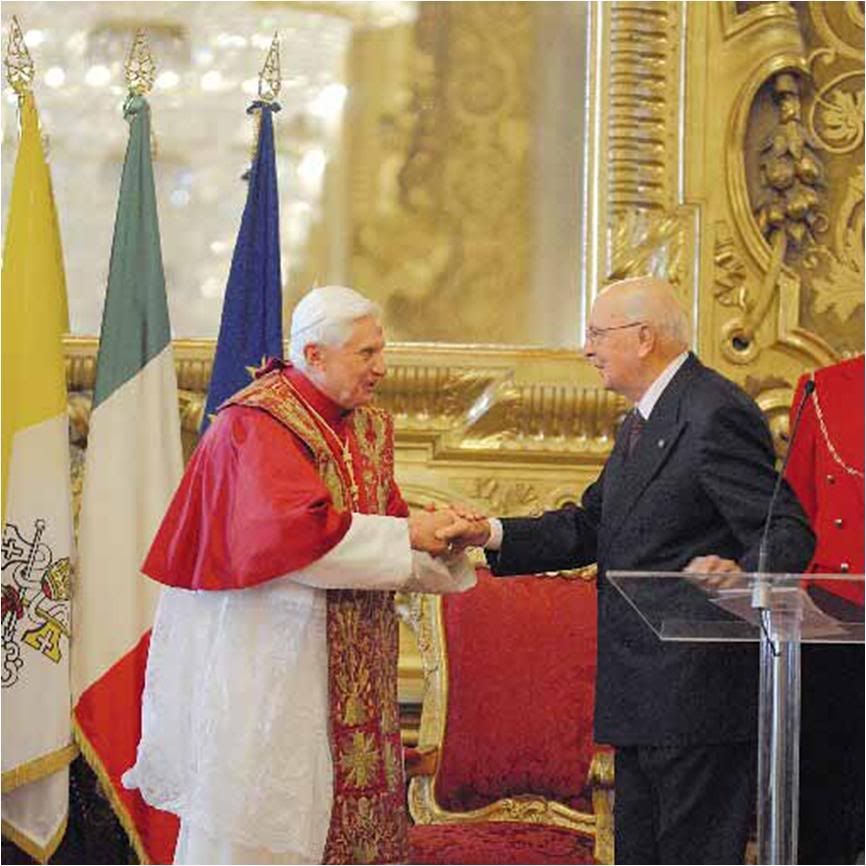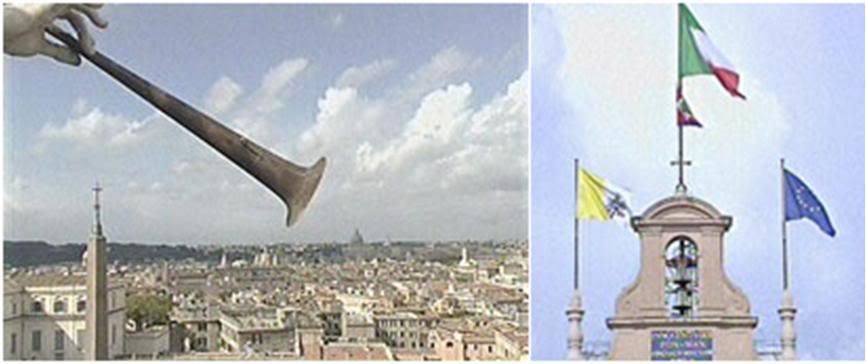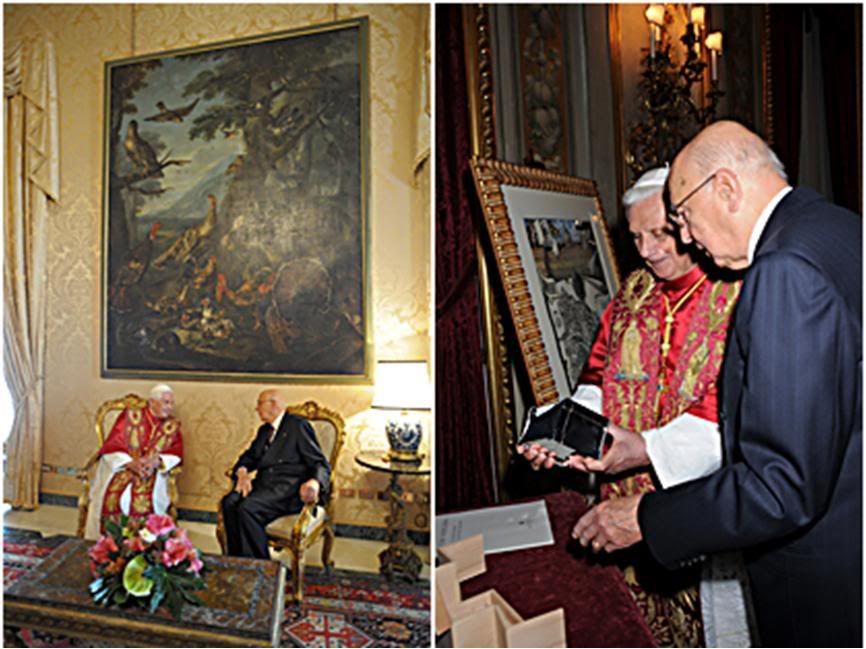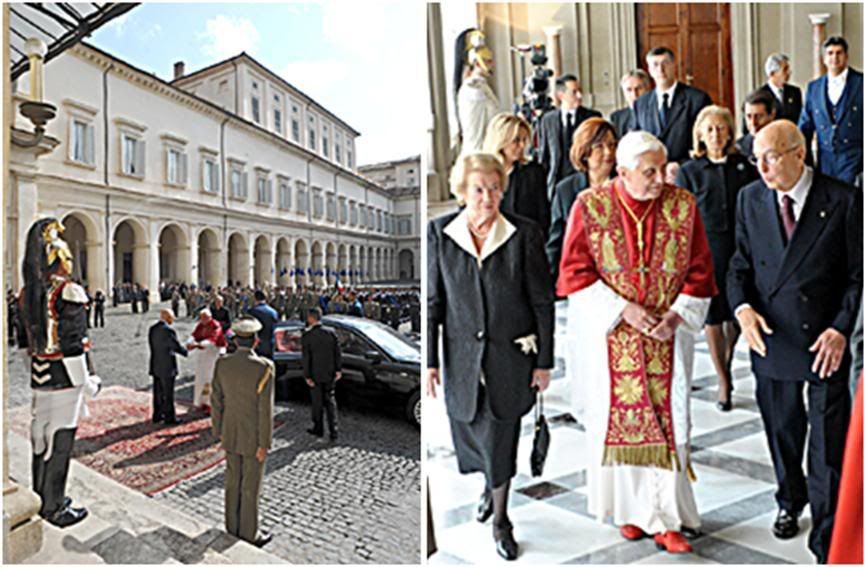 A common responsibility
A common responsibility
for Church and State
by Francesco M. Valiante
Translated from
the 10/5/08 issue of


At the Quirinale, the Pope feels he is in 'the symbolic house for all Italians'.
From the place which, after almost three centuries as the residence of the Popes, became a 'sign of contradiction' between the Church and the nascent unified Italian state, Benedict XVI today sees a much narrower Tiber.
Two of Rome's seven hills - the Vatican and the Quirinal - that no longer "ignore each other or confront each other with rancor", but "co-exist peacefully and collaborate fruitfully" in the service of the human being and social coexistence.
As President Napolitano confirmed, speaking of 'a relationship of reciprocal respect and fecund collaboration'. Which, he underscores, "does not in in any way obfuscate the distinction between the political and the religious'.
The Pope's visit to the President of the Italian Republic, on the day of St. Francis of Assisi, returns the visit made by the President to the Vatican on November 20, 2006.
But it was no act of mere institutional courtesy. The relaxed protocol, the accent on dialog and collaboration, the informal cordiality of gestures gave the meeting 'a value far more profound and symbolic', as Benedict XVI would point out in his speech.
The Italian President said that 'full adherence to the values of the (Italian) Constitution' that characterizes institutional activity does not exclude - but on the contrary, implies - a natural syntony with the Magisterium of the Church.
With particular attention to situations of injustice and social inequality, to the continual outbreak of hostilities in regions particularly prone to war and its attendant sufferings, to human dignity trampled on 'in all its forms and in all places' - and the lack of brotherly solidarity, above all in delicate and complex questions like that of immigrants - all of which call into question "the responsibilities and choices of governments".
The 'syntony' between the Pope and the President was evident, substantial, especially on the question of the 'educative emergency' - an undertaking towards 'the construction of a fraternal society truly animated by a sense of legality', as the Pope defined it, while the President referred to 'our common responsibility' to repair the 'damages from a corrosive collapse of ethics in economy and politics'.
There were other points of agreement - from young people and unemployment, to the needs of families and older people; from poverty and emargination, to how immigrants should be received.
Pope Benedict expressed his particular concern that religious freedom be protected to allow believers 'to do their part in the construction of the social order'.
Napolitano recalled with concern the danger of racism and reiterated that 'nothing can justify racial contempt and discrimination'.
There was no confusion nor opposition in their words. Secularity is something acquired. The Pontiff expressly reassured those who fear 'a prevarication that would damage freedom on the part of the Church and its members'.
In Italy - 'historically permeated with the ideal legacy and living presence of Christianity', the President acknowledged, a community whose only purpose is to 'serve man' cannot raise fear. And so he asked that the contribution of the Church 'be welcomed by all in the same spirit of willingness with which it is offered'.
If only because, he continued, "the sense of secularity of the State, which can be grasped from what the Constitution provides, embraces the acknowledgment of the social and political dimension of the religious fact".
As such, secularity implies 'not just respect for the search that moves the universe of the believer, but dialog', one founded on 'the non-dogmatic exercise of reason' and on its 'natural characteristic of self-questioning and openness'. Which is exactly the logic and thread that runs through the Ratzinger Pontificate.
The Vatican and the Quirinal:
Two hills very close to each other
Editorial by
Giovanni Maria Vian
Translated from
the 10/5/08 issue of

 Left, View from the Quirinal shows St. Peter's in the background; right, Vatican flag flying from a 'belltower' of what was once the residence of the Popes.
Left, View from the Quirinal shows St. Peter's in the background; right, Vatican flag flying from a 'belltower' of what was once the residence of the Popes.
The Quirinal and the Vatican not only look at each other in friendship, but express, in symbols and facts, a growing collaboration for the good of everyone and the dignity of every human being.
In Italy and the European context, but with a dynamic that can be exemplary even for other nations.
As two very significant anniversaries approach - the 80th of the Lateran Pacts of 1929 and the 105th of Italian unification (1861) - the encounter between the Pope and the President of the Italian Republic thus takes on an indisputable significance and must be welcomed as a truly important stage in the development of relations between Italy and the Holy See, which have been excellent.

Doubtless thanks to the personalities of Benedict XVI and Giorgio Napolitano; to the cordiality that marks the personal relationship between the Bishop of Rome and the head of the Italian state; to the multiple areas of institutional cooperation; and finally, to the daily commitment of numberless men and women, believers and not, who share citizenship in constitutional loyalty to that nation of which the Roman Pontiff is the Primate.
Like the two hills that face each other, the addresses of the President and the Pope almost mirrored each other.
Thus Napolitano underscored, with attentive exalted words, the reciprocal respect and collaboration between the Italian Republic and the Catholic Church, attention for the teaching of Benedict XVI, the ideal legacy and living presence of Christianity in Italy, the shared principles of justice, the need to consolidate peace and to affirm solidarity in Europe in the face of global phenomena such as that of migration and a rebirth of racism, attention to the educative dimension in the face of the ethical disorientation in the world of economy and politics, and finally, the acknowledgment - in Italian history and in the Constitution of the republic - of the social and public dimension of the religious fact, to which he adds that of the contribution of Catholics to the life of the nation.
Visiting the Quirinale - the papal residence for centuries, from which two Popes were forcibly taken away - Benedict XVI called it 'a sign of contradiction' that had been overcome by the Lateran Pacts, whereby the waves of the Tiber had carried out to the Tyrrhenian Sea the tides of the past, finally reuniting the two hills, in the image evoked by Pius XII on the tenth anniversary of the Pacts when, for the first time, a Roman Pontiff, came back to the hill that overlooks the Vatican.
And the reciprocal respect of the sovereignty of Church and State is a reality that can be verified in Italy every day. In the sign of St. Francis, recalled by Pius XI and John Paul II, which, according to Benedict XVI, well expresses the mission of the Catholic community in Italy.
Namely, a service to the human being which is its only purpose, so that there is no reason "to fear a prevarication that can damage freedom on the part of the Church and its members, who therefore expect that their freedom be recognized not to betray their own conscience illuminated by the Gospel".
Without any intentions of power or privileges. In order that Italy, as John XXIII once wished, may protect that 'sacred testament' which commits it before God and mankind.
Strange weather for the Pope's
trip across the Tiber
by ELISA PINNA
 One would not even have suspected it unless one was in Rome today or watching a broadcast of the Pope's visit to the Quirinale....
One would not even have suspected it unless one was in Rome today or watching a broadcast of the Pope's visit to the Quirinale....
Sun, rain, sun, rain. And finally a lightning bolt that violently struck the flag-flying Torrino over the Presidential palace, just a few minutes after Papa Ratzinger had left to return to the Vatican.
Unforeseen weather that was nasty at times marked the morning of Pope Benedict's visit to President Giorgio Napolitano. But that was the only flaw in an event that functioned to perfection and a morning marked by smiles all around and an almost family atmosphere.
The visit started at 11 a.m. on the dot, when the Pope's open-top limousine entered the courtyard of the Quirinale followed by two platoons of presidential guards on horseback.
Until a few minutes earlier, it had been drizzling. Now President Napolitano waited to greet the Pontiff at the entrance to the Vetrata (stained glass) Terrace.
They shook hands, then stood at attention as a military band played the Vatican and Italian anthems, with an honor guard of the Italian Marines and Aeronautics.

The program was planned to minimize time spent in protocol formalities in favor of more face time together. So while the Vatican flag was still being raised over the Torrino [which would be struck by lightning later), the President and the Pope were already greeting the official delegations waiting inside - with emeritus Presidents Oscar Scalfaro and Carlo Ciampi (missing was Francesco Cossiga, whom had lunch with the Pope in Bressanone last August), and Prime Minister Silvio Berlusconi who bent to kiss the Pope's ring.
After brief pleasantries, the President and the Pope proceeded to their private conversation. After about half an hour, they were joined by Napolitano's wife Clio.
In the Napoleonic Hall, Prime Minister Berlusconi and his foreign minister met with Cardinal Tarcisio Bertone and his two deputies, including Vatican 'foreign minister' Mons. Dominique Mamberti.
As he did when he first came to the Quirinale as Pope in 2005 (Ciampi was President), the Pope also asked to pray a few moments at the Chapel of the Annunziata.
It was after 12 noon when they proceeded to the Hall of Feasts - which used to be Consistory Hall when the Quirinale was the residence of the Popes.
The two heads of state delivered their addresses to a 'bipartisan' group of deputies and senators.
After that they exchanged gifts. The Pope gave the President a specially engraved map of 'Civitas Vaticana', while the President gave him a silver box depicting the gates of the Quirinal.
The Pope left shortly thereafter, seen off once more with military honors, and escorted in reverse back to the Vatican by the elite presidential guard.
The sun was shining, but a few minutes after the papal entourage left, down came a thunderstorm replete with thunder and lightning.
In the Pope's open-top car, the Pope's secretary held an umbrella over their heads just as they reached the Vatican.
I gave priority to translating the accounts in L'Osservatore Romano because I was aware that on Sunday, I would have to translate first the Pope's homily and Angelus message. However, there are a few excelent brief and postive reports in the Italian MSM that must be shared. I will trnslate them as time permits.
[Modificato da TERESA BENEDETTA 05/10/2008 19:03]